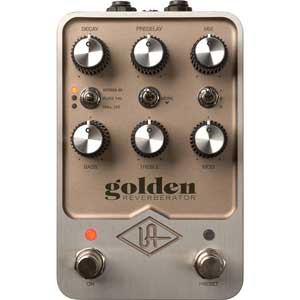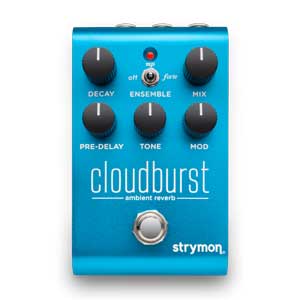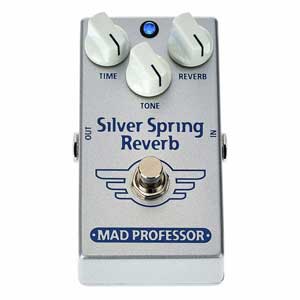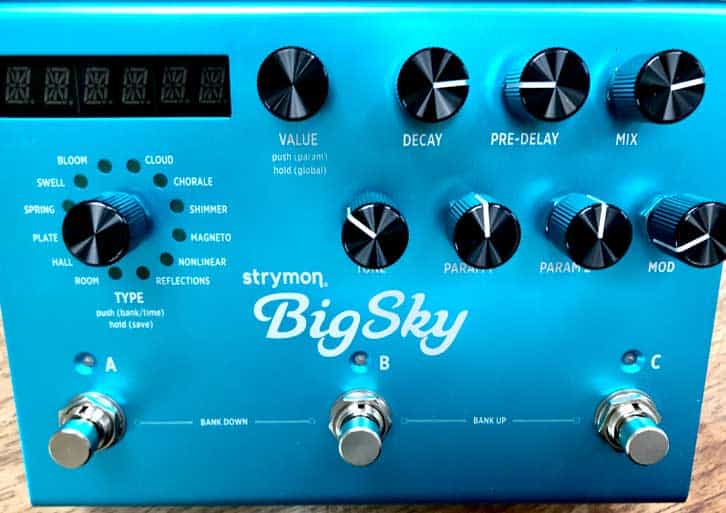Comparison Chart: Best Reverb Pedal
OUR TOP CHOICE
UAFX Golden Reverberator
Type of Reverb Pedal: Spring, Plate, Hall
Our Rating: 5.0

Check Price:
Pros
- Our Top Choice for Reverb Pedals
- Best quality classic reverbs on this list
- Responsive to your playing
- True Bypass
- Easy to use
Cons
- No power cable included
Source Audio Collider Delay + Reverb
Type of Reverb Pedal: reverb and delay
Our Rating: 4.6

Check Price:
Pros
- High-quality, expressive reverbs
- 7 reverbs and 5 delays combined.
- Reverb ‘freeze’ function
- Ability to combine two effects, reverb/delay, delay/delay, reverb/reverb
- Compact housing
- Midi I/O
- True bypass
Cons
- Included App is okay
EarthQuaker Afterneath V3
Type of Reverb Pedal: Ambient Soundscapes
Our Rating: 4.8

Check Price:
Pros
- Our favorite ambient reverb pedal
- Top quality ambient reverb simulations
- Sensitive controls make it a joy to improvise with
- Fantastic experimental sounds using the Drag Knob
- Compact Size
Cons
- Buffered bypass only
Strymon Cloudburst Reverb
Type of Reverb Pedal: Ambient Soundscapes
Our Rating: 3.8

Check Price:
Pros
- High-quality ambient reverb sounds from realistic to experimental
- Freeze Effect
- Loads of connectivity: Expression Pedal, TRS MIDI, USB-C
Cons
- Pricey for what it is
Eventide Space
Type of Reverb Pedal: do-it-all
Our Rating: 4.6

Check Price:
Pros
- Our Favorite Do-it-all Reverb pedal
- Rich, studio-quality traditional and experimental reverb sounds
- True Analog bypass
- MIDI and USB I/O, syncs with MIDI clock
- Exciting, subtle control of the effects with an expression pedal
Cons
- Some control functions are not immediately obvious
- Different power cable than most pedals – 9V, 500 mA
- A lot of basic functions can be controlled with the footswitches but comprehensive control will require hands
Strymon Big Sky
Type of Reverb Pedal: do-it-all
Our Rating: 4.0

Check Price:
Pros
- Quality classic reverb sounds that retain your guitar sound
- True Analog Bypass
- Useful Freeze function
- 12 Reverb Machines with multiple adjustable parameters
Cons
- Pricey
- No standard delay controls
- No USB connection
Fender Marine Layer
Type of Reverb Pedal: budget, Hall, Room
Our Rating: 4.6

Check Price:
Pros
- Our Favorite Budget Reverb Pedal
- Quality sound and build
- Low Price
Cons
- No Spring or Plate simulations
- About twice as large as it needs to be
TC Electronic Hall of Fame 2
Type of Reverb Pedal: budget, 8 reverbs
Our Rating: 3.4

Check Price:
Pros
- Low Price
- Mostly retains the sound of your guitar
- 8 different reverb simulations
- Compact Size
Cons
- Reverb simulations sound cheap compared to the competition
Boss RV-6
Type of Reverb Pedal: budget, 8 reverbs
Our Rating: 3.0

Check Price:
Pros
- 8 different reverb simulations
- True Bypass
- Compact Size
- Includes a Delay + Reverb setting
Cons
- Sound Quality is not up to par with the competition
- Tiny knob to switch between reverb modes
Surfybear Compact
Type of Reverb Pedal: Mechanical Spring, Analog
Our Rating: 4.6

Check Price:
Pros
- Best Spring Reverb sounds on this list
- Fully Analog with true bypass
- No dulling of the sound
- Obviously great for surf sounds, but also great at achieiving subtle spring reverb effects.
Cons
- Limited to spring reverb sounds only
- Takes up a lot of pedalboard space
- 12 V power cable
Silver Spring Reverb Mad Professor
Type of Reverb Pedal: Spring
Our Rating: 4.5

Check Price:
Pros
- Fantastic sound quality
- Clean analog dry signal, true bypass
- Compact Size
- Dead Simple
Cons
- Spring reverb simulation only
Why Get a Reverb Pedal?
A reverb pedal gives you the option to sculpt the space around your playing exactly to your liking. You might be gigging with different amps where some have reverb that you’re happy with and some have no reverb options at all. A reverb pedal will bring consistency, creative options, and more control to your sound.
Not all reverb pedals are created equal. You’ll find loads of options out there with different features and different circuits. For this buyer’s guide, we have broken down the pedals into the following types:
- Spring, Plate, Hall – pedals that focus on the classic natural reverb sounds of mechanical springs, plates, and room simulations.
- Delay + Reverb – pedals that combine the capabilities of delay pedals with reverb.
- Ambient – pedals for creating cinematic soundscapes with experimental effects that range from tight rooms to cavernous spaces with infinite decay times.
- Do-it-all – pedals that do everything related to reverb – classic reverb, delay, and ambient experimental sounds.
- Analog – pedals that focus on having a small footprint in your signal chain, some use mechanical springs.
- Budget – pedals that aim to give you everything they can on a tight budget.
We recommend placing reverb at the end of your signal chain. A good starting point is: Compressor – Wah – Drive – Fuzz – Modulation – Delay – Reverb.
How we Chose the Best Reverb Pedals
For this buyer’s guide, we shortlisted 11 of the most popular and most highly recommended reverb pedals out there. We tried to cover the wide range of reverb needs musicians have out there – from classic to ambient to do-it-all.
We tested all 11 pedals side-by-side to see how they compare and to see if they are worth the money. See here for all of our guitar gear reviews and all things audio equipment.
More on Guitar Pedals…
Our Top Choice
Universal Audio Golden Reverberator
our rating
5.0
Type of Reverb Pedal: Spring, Plate, Hall
Check Price:
Bottom Line:
Our favorite reverb pedal on this list. Classic reverb sounds that are rich, detailed, and expressive.
Ideal User of the UA Golden Reverberator
Guitarists and musicians looking for high-end classic reverbs in a pedal
Pros
- Our Top Choice for Reverb Pedals
- Best quality classic reverbs on this list
- Easy to use
Cons
- No power cable included
Our Take
This is our favorite pedal for those seeking high-quality classic reverb sounds. It retains the authentic sound of your guitar (no dulling of the sound) and produces the most beautiful, natural sounding reverbs on this list.
The digital emulations are high-resolution, with an analog feel in their response to your playing. They don’t sound like effects.
Based on classic reverbs of legendary Fender springs, EMT plates, and Lexicon 224, each of the settings delivers satisfying realism. The spring reverbs are exciting and boingy, giving authentic surf sounds as well as subtle flutter and bounce.
Quality plate reverbs are especially rare to find in pedals. The UAFX Golden Reverberator’s EMT 140-based plate sounds are the best you will hear today in a pedal. Here’s an example from our tests below:
Notably UA has released a single function pedal called Heavenly, which offers only these 1950s studio plate reverbs at a lower price.
The Lexicon 224 models include: Room A, Small Concert Hall A, Large Concert Hall B, Percussion Plate A, Constant Density Plate A, and Acoustic Chamber. I never wanted to hit the bypass on this pedal. Everything sounds good with it.
Source Audio Collider Delay + Reverb
our rating
4.6
Type of Reverb Pedal: Reverb + Delay
Check Price:
Bottom Line:
Excellent value Reverb + Delay pedal with high-quality sounds that are easy to use.
Ideal User of the Source Audio Collider
Anyone looking for a high-quality dual-use delay/reverb pedal
Pros
- High-quality, expressive reverbs
- 7 reverbs and 5 delays combined.
- Reverb ‘freeze’ function
- Ability to combine two effects, reverb/delay, delay/delay, reverb/reverb
- Compact housing
- Midi I/O
- True bypass
Cons
- Included App is okay
Our Take
We liked the Source Audio Collider first and foremost for its high-quality reverb sounds. They don’t sound like effects. They are rich in detail and expressive with your playing. We were especially impressed with the realism of spring reverbs from this unit. In fact, after the UA Golden Reverberator, this machine took second place in terms of raw sound quality.
Here’s an example from our tests with Tape Delay and True Spring Reverb:
The pedal is giving you a lot of power in a single compact-sized pedal. The Source Audio Collider is a combination of the company’s Nemesis Delay Pedal and Ventris Dual Reverb Pedal. With two independent 56-bit signal processors, the pedal offers combination effects of either delay/reverb, delay/delay, or reverb/reverb.

The Collider has a tap-tempo function on the delay side with delay effects such as Analog, Tape, Oil Can, and Reverse. The reverbs have a handy ‘freeze’ function to allow playing over a held effect. Reverb simulations include Spring, Plate, room, and hall simulations and a Swell, E-dome, and Shimmer effect.
Overall, this pedal offers excellent value as a quality dual-use pedal.
Best Ambient Reverb
EarthQuaker Afterneath V3
our rating
4.8
Type of Reverb Pedal: Ambient
Check Price:
Bottom Line:
Our favorite pedal for creating ambient soundscapes and experimental sounds. A joy to improvise with.
Ideal User of the EarthQuaker Afterneath V3
Anyone in the market for a compact ambient reverb pedal
Pros
- Our favorite ambient reverb pedal
- Top quality ambient reverb simulations
- Sensitive controls make it a joy to improvise with
- Fantastic experimental sounds using the Drag Knob
- Compact Size
Cons
- Buffered bypass only
Our Take
This was our favorite pedal for creating ambient soundscapes and cinematic reverb effects. The pedal is simply a joy to improvise on. Its six simple knobs are extremely sensitive with extended, gentle roll-offs.
Cavernous spaces with infinite decays, as well as EQ-shifting sounds and octave effects, are all easy to achieve with this pedal. But the real magic of it lies in the subtlety of the controls. All the controls are very sensitive and responsive to your playing: Length controls decay, diffuse controls the ambiance, dampen controls EQ, and Reflect controls the number of delays.
But the Drag knob is where things get very exciting. Clockwise tightens the delay time, smoothing things out, and counterclockwise breaks everything up. The tiny mode knob alters the way the pitch moves up and down with the Drag function. Used with an expression pedal, this Drag knob can open the rabbit hole in your experimental sound.
Check out this example from our tests below:
In addition to wild, experimental reverbs, this pedal does subtle as well. Using a low-mix and the damper knob, the Afterneath offers colors in the fuzzy, grungy, flangey range.
If you are looking for an ambient reverb pedal, look no further.
Strymon Cloudburst Reverb
our rating
3.8
Type of Reverb Pedal: Ambient
Check Price:
Bottom Line:
Quality ambient reverb pedal, but a bit pricey for what you get.
Ideal User of the Strymon Cloudburst
Anyone looking for a compact pedal that creates ambient reverb soundscapes
Pros
- High-quality ambient reverb sounds from realistic to experimental
- Freeze Effect
- Loads of connectivity: Expression Pedal, TRS MIDI, USB-C
Cons
- Pricey for a limited pedal
Our Take
The Strymon Cloudburst Reverb pedal offers a wide range of reverbs from tight room-like ambience to lush cavernous soundscapes. The ARM processor is an upgrade to the previous SHARC processors, with 32-bit floating-point processing that produces detail-rich reverb sounds. The compact pedal also offers loads of connectivity with inputs for an Expression Pedal, TRS MIDI, and USB-C.

The most interesting sounds from the pedal come from the three-way ensemble switch. This creates harmonic modeling that outdoes any standard ‘Shimmer’ effect on other pedals. You can hear it in this example from our tests below:
On the whole, it feels like you could create most of these sounds using other pedals on this list. Given the rather high price tag of this pedal, for ambient reverb, we found that EarthQuaker Afterneath offered much more joy and value.
Best Do-it-all Reverb Pedal
Eventide Space
our rating
4.6
Type of Reverb Pedal: Do-it-all
Check Price:
Bottom Line:
Our favorite do-it-all pedal with studio-quality reverbs from realistic to insane.
Ideal User of the Eventide Space
For all musicians – not limited to guitarists – looking for studio-quality classic and experimental reverbs in a hands-on stompbox. For use with any DAW, synth, vocal, drums, or instrument you can send through a pedal.
Pros
- Rich, studio-quality traditional and experimental reverb sounds
- True Analog bypass
- MIDI and USB I/O, syncs with MIDI clock
- Exciting, subtle control of the effects with an expression pedal
Cons
- Some control functions are not immediately obvious – takes some time to get to know the manual and machine
- 9V, 500 mA power cable means you need a different cable on your pedal board
- A lot of basic functions can be controlled with the footswitches but comprehensive control will require hands

Our Take
The machine’s effects are based on 12 effect algorithms with origins in Eventides’ studio machines like the H8000 and Eclipse. The algorithms are Hall, Room, Plate, Spring, Dualverb, Reverse, ModEchoVerb, Blackhole, MangledVerb, TremeloVerb, DynaVerb, and Shimmer.
The sound quality is fantastic on the 100 preloaded presets. From realistic rooms to experimental soundscapes, the Eventide Space does it all. Below, you can hear two examples from our tests: first, a tight room with the ‘Adapt-a-room’ preset followed by an experimental example with the ‘Hey Honey’ preset:
Using an expression pedal, this machine comes to life. With your pedal at 0, adjust a few knobs, then give the pedal full gas and adjust a few more. The pedal will then morph the sound based on the adjustments you made, with some pretty wild results. For example, you can ‘stretch’ a spring reverb from tight to loose in realtime.
On the downside, the intricacies of the machine and its controls are not immediately obvious. For example, it might take some time with the manual to get into the weeds of MIDI clocking with this machine.
Overall, we found this to be a quality do-it-all reverb unit that we can highly recommend.
Strymon Big Sky
our rating
4.0
Type of Reverb Pedal: Do-it-all
Check Price:
Bottom Line:
A quality do-it-all reverb pedal but we think the Eventide Space offers better value.
Ideal User of the Strymon Big Sky
Anyone looking for a quality do-it-all reverb pedal.
Pros
- Quality classic reverb sounds that retain your guitar sound
- True Analog Bypass
- Useful Freeze function allowing you to play over the top of any effect
- 12 Reverb Machines with multiple adjustable parameters
Cons
- Pricey
- No standard delay controls (there are delay effects built into some of the presets, but there is no standard delay setting with tempo control)
- No USB connection

Our Take
Since its release, this reverb pedal has been the go-to for guitarists seeking increased functionality beyond spring reverbs. This is a pedal that can deliver studio-quality sound on reverb sounds from plates to experimental spaces.
Technically, the Big Sky offers power and options. The Big Sky has the option of true or buffered bypass, and its dry signal path is completely analog, even when the effect is engaged. The unit runs on SHARC DSP which provides 32-bit floating-point processing. The cabinet emulation filter gives you options for direct recording or direct-to-PA connections without sacrificing any natural tone.

The classic reverb sounds such as spring, plate, and hall from the Big Sky are quality. However, we didn’t find this unit to be as full or expressive as the UA Golden Reverberator, but very impressive nonetheless.
The Freeze function can be activated by pressing and holding your active footswitch. This is a great additional function to this unit that allows you to play over the top of any effect.
The Big Sky is a user-friendly do-it-all reverb pedal. The basic functions are obvious and the complexities can be learned quickly. From its myriad of excellent presets, highlights include the Choral setting, which allows you to switch parameters such as vowel choice (from ‘Ooh’ to ‘Ahh’) which sounds super cool with rhythm guitar. Or the Swell setting, which produces an EBow effect on your playing. Magneto and Nonlinear settings also produce some pretty wild delay effects worth trying out.
Overall, we liked this machine but felt it was overpriced considering the competition. For a do-it-all reverb unit, we felt that the Eventide Space and Source Audio Collider offer more for the money.
Budget Pick
Fender Marine Layer
our rating
4.6
Type of Reverb Pedal: Budget, Hall, Room
Check Price:
Bottom Line:
Our favorite budget option: quality reverb sounds at a low price.
Ideal User of the Fender Marine Layer Pedal
Those on a budget who want quality reverb sound that retains the tone of your guitar.
Pros
- Quality sound and build
- Low Price
Cons
- No Spring or Plate simulations
- About twice as large as it needs to be
Our Take
This is our favorite reverb pedal for those on a budget.
The Fender Marine Layer is a great budget reverb pedal with quality sound that retains the sound of your guitar. The reverbs are essentially room simulations with some options to make the room larger and smaller. We thought the sound was surprisingly great for the price – the room and hall simulations sound real, with no dulling of the sound. Most importantly, it doesn’t sound like an effect.
The unit comes with 3 reverb algorithms: Hall, Room, and Special. There are two Hall options, two room effects, and a Shimmer effect. Along with pre-delay, reverb time, and level, there is a damping knob to attenuate the high end and a filter to adjust the attenuation range.
The pedal is about twice the size of a normal small pedal. It seems unnecessarily large, but it looks cool and it sounds great. Notably, the pedal lacks any true spring reverb simulation (or plate).
TC Electronic Hall of Fame 2
our rating
3.4
Type of Reverb Pedal: Budget, 8 reverb simulations
Check Price:
Bottom Line:
Okay sound, cheap.
Ideal User of the Hall of Fame 2
Those on a budget who seek a cover-all-the-bases pedal
Pros
- Low Price
- Mostly retains the sound of your guitar
- Compact Size
Cons
- Reverb simulations sound cheap compared to the competition
Our Take
The Hall of Fame 2 is a solid reverb pedal for those who want loads of effect sounds on a budget. The small unit boasts 8 reverb simulations: Room, Hall, Spring, Plate, Church, Shimmer, Mod, and Lo-Fi. Sadly, the sound quality of the reverbs mostly sounds like the cheaper effects you might find on a modeling amp. While it retained the sound of my guitars mostly, the reverb that rolls in at the end lacks the depth and resolution of other pedals on this list.
The footswitch on the pedal is pressure sensitive and can act sort of like an expression pedal using the MASH function. We found this feature to be not all that workable or exciting.
Overall, if you want a good reverb pedal on a budget, get the Fender Marine Layer or be prepared to spend a bit more.
Boss RV-6
our rating
3.0
Type of Reverb Pedal: Budget, 8 reverb simulations
Check Price:
Bottom Line:
Loads of options, low price, meh sound.
Ideal User of the RV-6
Guitarists on a budget who want a lot of different reverb effects in a small pedal.
Pros
- Using input A, the signal passes through as clean analog
- Compact Size
- Includes a Delay + Reverb setting
Cons
- Sound Quality is not up to par with the competition
- Tiny knob to switch between reverb modes
Our Take
The RV-6 is an ambitious budget pedal offering 8 reverb effects including a delay+reverb setting and a tone knob that adjusts 10 different parameters with each turn. It can be connected to an expression pedal for rolling reverb in and out at will.
Given all that it offers, and considering this is the 6th generation of this pedal, we had high hopes that this would be our choice budget pedal. Compared side-by-side with the other pedals on this list, however, the sound quality is just not as good. The guitar tone is dulled a bit and the reverbs themselves are not as rich nor as expressive as other pedals on this list.
If budget is your concern, you get more quality for your money with something like the Fender Marine Layer.
Surfybear Compact
our rating
4.6
Type of Reverb Pedal: Mechanical Spring, Analog
Check Price:
Bottom Line:
Great analog reverb pedal for classic mechanical spring tank sound.
Ideal User of the SurfyBear Compact
Guitarists who want authentic, analog spring reverb in a pedal.
Pros
- Best Spring Reverb sounds on this list
- Fully Analog with true bypass
- No dulling of the sound
- Obviously great for surf sounds, but also great at achieiving subtle spring reverb effects.
Cons
- Limited to spring reverb sounds only
- Takes up a lot of pedalboard space
- 12 V power cable means you cannot daisy chain your 9V connections on a pedalboard
Our Take
This is the best spring reverb sound on this list, especially if you are seeking a surf sound. There’s nothing in the way of the sound of your guitar. It just sounds exciting and real, like a 1960s Fender 6G15 Reverb Unit. Check out this example from our tests below:
It is a redesigned smaller version of SurfyBear’s classic Reverb pedal. It works by sending the signal through actual mechanical springs which you can see at the bottom of the pedal. (Be sure to take the foam damper off before you use the pedal!)

Although it is ‘smaller’, measured at 25 X 12 X 6 cm, be aware that it’s going to take some serious room up on your pedalboard. The SurfyBear Metal is about twice the size with a similar sound to this pedal, albeit slightly fuller in sound.
We also loved this pedal as a subtle reverb on your guitar sound. By rolling off the tone knob on the pedal, you can achieve some beautiful subtle effects as well as boingy surf. You can also use the pedal as a clean signal boost with the mix turned off.
Mad Professor Silver Spring Reverb
our rating
4.5
Type of Reverb Pedal: Budget, Spring
Check Price:
Bottom Line:
Lovely sound from a super-simple pedal.
Ideal User of the Mad Professor Silver Spring Reverb Pedal
Guitarists looking for excellent quality spring reverb in a compact pedal
Pros
- Fantastic sound quality
- Clean analog dry signal, true bypass
- Compact Size
- Dead Simple
Cons
- Spring reverb simulation only
Our Take
The Mad Professor Silver Spring Reverb Pedal delivers fantastic reverb that sounds like reverb you might find on a warm tube amp. It lacks the boingy, exciting spring sounds and surfy bounce, but what it does deliver sounds fantastic.
With three knobs and a bypass switch, it is the simplest pedal on this list. It gives you a reverb that sounds a bit like a blend of a spring reverb and a room. Increasing the level simply makes the room larger.
We liked that it retained the tone of the guitars we tested it with and never sounded like a cheap reverb effect. If you need a simple pedal that will give you a consistent, musical reverb bloom regardless of what amp you’re gigging with, look no further than the Mad Professor Silver Spring.
Questions or Comments?
Follow the discussion here on Facebook.

